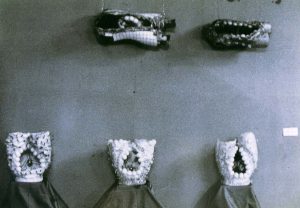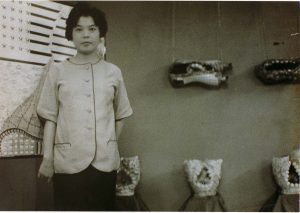田部光子 TABE Mitsuko

《たった一つの実在をもとめて》2013年 アクリル、木炭、コラージュ、純金箔、純プラチナ箔、シルクスクリーン 180×100cm(×6),180×35cm(×3)「田部光子新作展」みぞえ画廊 2013年11-12月展示風景 撮影:小勝禮子
Searching for One and Only Existence, 2013, Acrylic, Charcoal, Collage, Gold leaf, Platinum leaf on Silkscreen Print 180×100cm(×6),180×35cm(×3)
Installation view at Mitsuko Tabe New Works Show at Mizoe Art Gallery, Fukuoka, Nov.- Dec. 2013 Photo by KOKATSU Reiko
田部光子 TABE Mitsuko
1933年台湾生まれ。福岡に在住、活動。2024年3月6日、逝去。
1950年代末の田部光子の画家としての出発から、九州派時代と重なる60年代の活動について、その特徴を掲げてみよう。水爆実験、水俣病の時代を出発点として、三井三池炭坑争議やベトナム戦争などに敏感に反応する社会的問題意識と、女性だけに課せられる妊娠や出産という性に伴う義務に対するジェンダー的な問題意識を制作動機として、アスファルト・ピッチ、オブジェ、コラージュ、ハプニングといった、当時の前衛美術の先端である斬新な手法を使って、社会性とジェンダーを渾然と融合させたのが、他の九州派の作家たちとは異なる、田部独自の特徴と言えよう。
筆者は「前衛の女性1950-1975」という展覧会を企画・開催したが、その調査の中で、「前衛」という選民意識において「女性」はつねに他者であり、大衆の側にあって排除されるものだという、前衛グループの男性メンバーのエリート主義を強く意識せざるを得なかった。むろんそうした選ばれた少数の「前衛芸術家」という神話も既に成立しなくなっていたことが、1962年当時から批評家によって指摘されていたが、それでもなお戦後現代美術史は、前衛芸術運動の台頭と交替の歴史として、その後も記述されて来たのである。(略)
しかし田部光子の芸術を評価するには、こうした前衛の「英雄的」悲壮感とは別の視点が必要であろう。それは、「反権力」「反芸術」「反東京」を掲げた芸術運動を英雄的に讃えるような「マッチョ」的視点ではなく、運動の熱気の渦中から一歩離れて、冷静に観察しつつ、ジェンダーの表現に軽やかなユーモアを加味するような視点であるように思う。すなわち、田部自身が1999年にアメリカの大学での講演で語ったような、「非芸術で遊ぶ」という境地こそが、田部芸術の理想の到達点ではなかろうか。
九州派が解体して後、反万博に始まる過激な政治性を帯びた「集団蜘蛛」の活動に同伴して8ミリ映像を残し、九州女流画家展を主宰し(1974-84年)、地球郵便局を開設したメール・アート、ボックス・オブジェや〈Apple Series〉のコラージュ、手話を使った〈Sign Language Series〉など、1970年代から現在に至るまで、田部光子の活動はたゆむことなく続いている。
小勝禮子「田部光子試論―『前衛(九州派)』を超えて」より一部抜粋して修正、『美術運動史研究会ニュース』No.93、2008年5月、pp.1-9(『田部光子』みぞえ画廊、2012年、pp.62-73に再録)
Born in 1933, Taiwan. Lives and works in Fukuoka, Japan. Passed away on March 6, 2023.
This essay has raised essential characteristics of Tabe’s art, beginning with her early years in the 1950s as a painter and her Kyūshū-ha period during the 1960s. Her social awareness quickly responded to A-bomb tests and Minamata disease in the beginning, and then to Mitsui Miike Coal Miners’ Conflicts and Vietnam War which I did not cover in this essay. Her art was also motivated by her awareness of gender inequality regarding obligations placed only on women, such as, pregnancy and child birth. Unlike other Kyūshū-ha members, Tabe merged issues of society and gender, using then cutting-edge methods in avant-garde art, such as, asphalt pitch, object, collage, and happening.
When I organized the exhibition “Zen’ei no Josei 1950-1975” (Women artists in avant-garde movements, 1950-1975), I became strongly aware of the elitism of male members in avant-garde groups to exclude women as “Others” from the chosen “avant-garde.” Some critics were already pointing out as early as in 1962 that such a myth of chosen “avant-garde artists” became invalid (26), but history of postwar contemporary art has been consistently written as a history of emergence and replacement of avant-garde movements. (……)
We need an alternate point of view other than such “heroic” nostalgia for the avant-garde in order to evaluate the art of Mitsuko Tabe. That would not be a “macho” perspective which praises the artistic movement that sought “anti-power,” “anti-art,” and “anti-Tokyo” as heroes, but a perspective that distances itself from the vortex of heat of the movement, makes careful observations, and finds light humor in Tabe’s expression of her gender. Hence, the attitude of “playing with non-art” which Tabe mentioned in her lecture at an American university in 1999 (29), may be the ideal goal of Tabe’s art.
Tabe’s activity has evolved without interruption since Kyūshū-ha’s dissolution in the 1970s: she produced an 8 mm film documentary of anti-Expo political activities of Group Kumo (group spider) around 1969-70, organized the annual Kyūshū Women’s Art Exhibition (1974-84), initiated the Earth Post Office for mail art, and created boxed objects, collages of Apple Series, and Sign Language Series.
Excerpt from Reiko Kokatsu, “Mitsuko Tabe : Beyond Kyushu-ha”, n.paradoxa, vol.27, january 2011, pp.38-46. Translated by YOSHIMOTO Midori
https://www.ktpress.co.uk/nparadoxa-volume-details.asp?volumeid=27
田部光子の作品情報は、画廊のウェブサイト等をご覧ください。
Please refer to the gallery’ s websites for the works by TABE Mitsuko.
https://mizoe-gallery.com/products/list?category_id=184
http://www.yart-gallery.co.jp/MitsukoTabe.html
AWARE : Archives of Women Artists, Research & Exhibitions
https://awarewomenartists.com/en/artiste/mitsuko-tabe/
AWARE-日本

《プラカード》1961年 印刷物、真鍮、墨、塗料、ニス、紙(襖) 86.4×92.8㎝ 福岡市美術館蔵
Placard, 1961, Printed matter, Brass, Sumi ink, Paint, Varnish on Paper(Fusuma), 86.4×92.8㎝ Collection of Fukuoka Art Museum


左:《人工胎盤》1961年
右:田部光子と作品 1961年 銀座画廊(東京)にて
『田部光子MITSUKO TABE Recent Works』ギャラリーとわーる、2002年、p.12より
left: Artificial Placenta, 1961, right: Tabe Mitsuko in front of her works, Placard and Artificial Placenta,
Ginza Gallery, Tokyo, 1961 from MITSUKO TABE Recent Works, Gallery Toile, 2002, p.12

《人工胎盤》1961/2004年再制作 マネキン、ピンポン玉、合成綿、真空管、電気コード、ヒートン、特殊釘、布 49.8×49.4×41.8cm(×3) 熊本市現代美術館蔵
Artificial Placenta, 1961/ reworked in 2004, Mannequin, Ping-pong ball, Synthetic cotton, Vacuum tube, Electrical cords, Nail, Cloth, 49.8×49.4×41.8cm(×3) Collection of Contemporary Art Museum, KUMAMOTO

《魚族の怒り》1959年 油彩、アスファルト、竹、板 130.2×162.2㎝ 福岡市美術館蔵
Anger of Fishes, 1959, Oil, Asphalt and Bamboo on Board, 130.2×162.2㎝ Collection of Fukuoka Art Museum

《繁殖する2》1958/88年 油彩、アスファルト、石膏、竹、板 92.2×130㎝ 福岡市美術館蔵
Breeding 2, 1958/88, Oil, Asphalt, Plaster and Bamboo on Canvas, 92.2×130㎝ Collection of Fukuoka Art Museum

《Sign Language》1996/2010年 油彩、石膏、金箔、印刷物、板 129.7×119.8×6.5㎝ 福岡市美術館蔵
Sign Language, 1996/2010, Oil, Plaster, Gold leaf and Printed matter on Board, 129.7×119.8×6.5㎝ Collection of Fukuoka Art Museum

